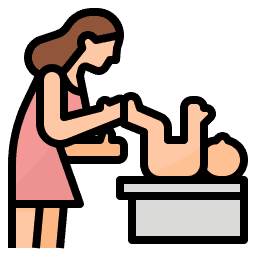how to fix pebble poop
Did your little one pass their first bowel movement, and you're worried the color isn't normal? Did you know that baby poop comes in nearly all hues and textures?
One thing your parenting manuals may not have taught you is that you'll spend the next few years being overly concerned about your baby's poop. It can give you greater insight as to your baby's health.
We'll break down the different types of baby poop, explain what's normal, and what you should look out for.
- Types of Baby Poop and What They Mean
- Baby Poop Colors and What They Mean
- Baby Poop Warning Signs
- How Often Should Baby Poop?
- Why Isn't Baby Pooping?
- Types of Baby Poop Smells
- Babies' Poop Faces
- The Poop Scoop
Types of Baby Poop and What They Mean

There are five types of baby poop — newborn, breastfed, formula, solid, and partially digested.
Be aware that your baby's bowel movements will depend a lot on their diet.
Let's have a closer look at the types:
1. Newborn Poop (Meconium)
During your baby's first days outside the uterus, they pass a tar-like, greenish-black poop (1). It's sticky, and some describe it as having a motor oil appearance. It can scare parents who aren't prepared for such a color.
Newborn poop, or meconium, consists of everything your baby ingested while in utero. This includes amniotic fluid, skin cells, mucus, and other substances. It doesn't have any traces of breastmilk or formula just yet, as it's a starter for the intestinal tract. Most infants pass a meconium stool within the first 24 hours of life.
After the first two to four days, the meconium changes color and texture, meaning it's now a transitional stool. Expect a lighter color (think army green), with a less sticky form. Once you see this poop, it means your little one's intestinal tract is working, and he or she has begun to digest breast milk or formula.
Sometimes it happens that babies pass meconium before delivery. This is generally due to infections, gestational age over 40 weeks, or a tough delivery causing physiologic stress to the baby. It's easy to notice through the amniotic fluid, which turns green or brownish as opposed to being transparent (2).
Passing meconium before birth can have dire effects on the baby, and extra care must be taken following delivery. You may notice a neonatal team in the delivery room, ready and waiting to assess your baby after birth. The baby is likely to ingest some of the stool, triggering something called meconium aspiration syndrome, which causes a lung condition that can turn deadly (3).
On the other hand, some babies have a blockage issue, hindering them from passing meconium even after birth. If your baby doesn't have its first bowel movement within 24 hours, your doctor will look for issues. These can include an underdeveloped anus, intestinal blockages, or meconium plug (stuck stool).
2. Breastfed Poop
Healthy breastfed baby poop is yellow, but can sometimes appear slightly green. It should have a creamy, mushy consistency, and may be textured with seed-like flecks. Many describe it as having a loose Dijon mustard mixed with cottage cheese look to it (sorry to Dijon or cottage cheese lovers!).
The consistency can vary. Sometimes, it's runny enough for parents to confuse it with diarrhea (4). Breastfed poop depends highly on what you ate and how much your baby is ingesting. Expect your baby to pass small "squirts" of these stools during feedings as well as more voluminous ones between feedings.
Don't get spooked if the poop suddenly appears more green than yellow. If so, try to retrace what you had for dinner the day before. As long as your baby isn't experiencing other symptoms such as fever or vomiting, you shouldn't worry.
3. Formula-Fed Poop
Formula-fed poop is different from breastfeeding poop. It's denser in texture and browner in color — it can be yellow-brown, tan-brown, or greenish-brown. Many compare it to peanut butter.
Formula-fed babies also pass fewer bowel movements, sometimes only every 2 to 3 days, but they're significantly larger.
4. Solid-Fed Poop
As you begin to introduce some solid foods such as infant cereal, pureed fruits, or vegetables, the poop will change. Typically, this is at around four to six months — keep in mind that the solids are used as a complement to breastmilk or formula.
The consistency becomes thicker, and it develops into a browner or darker color. It's especially noticeable if you've otherwise been exclusively breastfeeding.
5. Partially Digested Poop
Once your baby eats more solid food, such as boiled carrots or blueberries, you'll likely notice some chunks in the diaper (5). Your baby's diet greatly influences the color. Their poop could be red from beets, blue from blueberries, or even green from spinach and peas.
Chunks are normal since your baby's stomach is still getting the hang of metabolism. Some of the food may pass so fast that there's only time for partial digestion. It's not unusual to see fruit skins such as those from blueberries or grapes.
Pieces are probably also due to your baby's lack of teeth if you're starting solids early. Your little one may swallow before chewing everything through properly, which is also completely normal.
Baby Poop Colors and What They Mean

As we mentioned, baby poop comes in all hues — it's easy to get surprised by a sudden change.
It's crucial to know what different colors mean as some could indicate a problem. Here's a breakdown of colors and what they imply:
1. Black

Although black seems like a red flag warning, it's normal during the first days following birth. Meconium can vary in colors from dark green to black, which is why many compare it to motor oil.
Black poop, however, isn't normal or healthy if it continues for more than a few days. It shouldn't occur later during infancy. If it does appear, the color could be due to diet from grape juice, licorice, or even Oreo cookies.
If your child hasn't had any black foods, they may have ingested cigarette ashes, perhaps even charcoal. It could also appear due to medicines like iron supplements or bismuth.
If none of the above apply, black, tar-like poop occurring after three months could indicate bleeding in the stomach. It's a condition called melena, which causes bleeding in the digestive tract (6).
You won't see bright red blood in the stool. Instead, the acids in your baby's stomach turn the blood into a sticky, black substance, giving the stool a tar-like appearance. Contact your doctor if you discover this.
2. Green

Green stools are not an immediate cause for concern and are often influenced by diet. It's easy to confuse dark green with black poop under poor lighting. If you're in doubt, smear some stool onto a white paper, and the green hue should show.
If the stool is dark green, it's generally due to bile. However, green vegetables such as spinach can also create a similar tone.
Babies with diarrhea may pass green stools as well, due to the fast transit time. Medicines are another common culprit of greenish poop, but you can always contact your pediatrician if you're concerned.
In clinical practice, I frequently see green stools when infants have an upper respiratory infection. Streaks of mucus can be noted within the green stool. Since infants cannot blow their noses or expel nasal mucous any other way, they swallow it and pass it in their stools. If there is blood along with the mucous, it is an entirely different problem and should be discussed with your pediatrician.

Editor's Note:
Dr. Leah Alexander, MD, FAAP
3. Red

Red is another color that may spook parents since we tend to relate it to blood. Fortunately, much like green, it's significantly impacted by your baby's diet.
Red foods such as beets, tomato skins or juices, and sweets like Jell-O, can become noticeable in your baby's stool. It's been estimated that 90 percent of the so-called "bloody poop" is not generated by blood. Medicines such as Amoxicillin can also influence the color.
When I prescribe the antibiotic Cefdinir, I always warn parents to expect a change in stool color. (7)

Editor's Note:
Dr. Leah Alexander, MD, FAAP
When blood is the culprit, it's not necessarily from the baby. A mother's bleeding nipples from breastfeeding is a common cause of blood-traced stool.
However, sometimes it can be due to bleeding in the lower gastrointestinal tract, which will require a visit to the doctor. Milk protein allergy is the most common cause of intestinal bleeding in infants. Blood and mucous typically appear 2 to 3 weeks of age, and are often associated with excessive crying and discomfort. Poor weight gain occurs in severe cases. If you notice these symptoms, call your doctor. It may be necessary to switch to a hypoallergenic formula. For breastfed infants, some moms choose to withhold dairy from their diet in order to continue breastfeeding. Fortunately, most infants who initially have a milk protein allergy outgrow it by their first birthday (8).
4. Mustard Yellow

Mustard yellow indicates the end of the meconium phase when your baby begins to digest breastmilk or formula.
This color is most common in breastfed babies, as formula tends to make the stool browner in tone.
5. Bright Yellow
Bright yellow stool is another standard color seen after the meconium phase, generally in breastfed babies.
The color yellow can also be a sign of diarrhea, especially if the poop is quite runny or leads to blowouts.
If your baby has diarrhea, contact your doctor for advice on how to avoid dehydration (9).
6. Orange

Orange poop is typically caused by pigment from foods. It's not unusual after your baby had a meal consisting of pureed carrots.
This shouldn't be a cause for concern unless your little one is experiencing other symptoms like fever.
7. Greenish Tan

This is a common color seen in formula-fed babies and those eating solids.
It's not a typical color to spot if you're exclusively breastfeeding, though it's still not a cause for concern if you do.
Baby Poop Warning Signs

Not all textures and colors are normal. Your baby's stools serve as a clue for what's going on in the body (10).
Here are some things you should look out for:
1. White Poop
White poop is not normal and could be a sign your baby's liver isn't producing enough bile for digestion. It's a serious issue and should always be addressed by your pediatrician.
Bile is what gives stools the natural brownish color. A lack of bile can be caused by a liver disease such as hepatitis. Sometimes, there's an object like a gallstone or tumor blocking the bile ducts (11).
2. Grayish Poop
Grayish poop with a chalky consistency can also indicate a problem with your baby's bile production. This type of stool looks very similar to white stools.You should address this with your pediatrician immediately. In contrast, dark gray stools tend to be diet related and are normal.
3. Foamy Stool
A foamy or frothy stool is common in babies and is typically easy to fix. It's usually caused by the lower fat content of foremilk compared to hindmilk (12).
It's essential to understand the two types of breast milk — foremilk and hindmilk. Foremilk is the first milk your baby gets when they begin to nurse, and is high in protein. After a couple of minutes, your baby activates the hindmilk which has a even more protein along with more fat and Vitamins A and E.
Because foremilk contains less fat, your baby may be hungrier and feed more frequently if not latching on for a full 10 to 15 minutes. You can correct this by nursing your baby on the last breast they nursed on before. If it continues, contact your pediatrician.
4. Stringy Poop
If there are stringy, slimy streaks that are greenish in color present in your baby's stool, it's a sign of mucus. Excessive drooling can cause this, and it generally peaks around the time your little one gets teeth.
However, it can also be a clue that an infection is lurking. If it persists or there are other signs of illness, contact your doctor.
5. Hard Pebbles
If your baby is passing hard, round pebbles, it's a sure sign of constipation. The pebbles may vary in sizes and shapes, but they're likely to be making your baby uncomfortable.
The most common cause of constipation is less frequent feeding, or reduced amount of breastmilk or formula intake. In other words, it is a fluid issue. My first recommendation is to breastfeed more frequently during the daytime, or to offer an extra ounce of formula at each feeding. For infants older than 6 months, sips of water can be offered between breast or formula feedings.
A common assumption among parents, however, is that the baby is "constipated" if he or she hasn't stooled for several days, then ultimately passes a large liquid stool. If the stool is loose or soft, the baby is not constipated.
You can expect to see some blood. The blood, however, is typically from the anus and not a deeper issue (13).
Constipation is common when you're beginning to introduce solid foods. If it continues, consult your pediatrician who may recommend water. Water is not safe prior to 6 months old; formula and breastmilk should be the only fluids given. Because of the high sugar content, juice is not an ideal remedy. In fact, the American Academy of Pediatrics has issued an updated policy on juice and other beverages that infants and children consume (14). It is better to offer more fruits such as prunes, peaches, plums, and mangoes than juice.
6. Red Bloody Stool
Red blood found in the stool can be a sign of allergies to food items such as milk products. It can, however, also indicate a bacterial infection and should be addressed by your pediatrician (15).
7. Runny Stool
During the first month, it's normal that the stool is a little runny. What's not normal is when it comes out green or bright yellow. The color change is a sign of diarrhea, and measures should be taken to stop it.
If diarrhea remains untreated, it can quickly lead to dehydration. We recommend contacting your pediatrician if you suspect diarrhea as it could indicate an infection or allergy.
Always Consult A Doctor
If you fear your baby is dehydrated, always ask your doctor for treatment options. Never give water to babies under six months unless otherwise instructed. Doing so could hinder your baby's body from absorbing nutrients from breastmilk or formula (16).
How Often Should Baby Poop?

How often your baby should poop depends on whether they're breastfed or formula-fed.
You should also keep in mind that not all babies are alike, and some will go more frequently than others. If you're concerned, contact your pediatrician.
Breastfeeding Babies
Usually, babies who are exclusively breastfeeding follow a loose pattern of one poopy diaper for every day of their life. Their first day, they'll have one bowel movement, the second day, they'll have two, and so on.
This loose pattern generally ends by day five where your baby will poop more frequently. You may find a stinky surprise every time you open up the diaper. That said, it's not uncommon for some infants to go a day or two without having a bowel movement (17).
At around the six-week mark, your baby's bowel movements may slow down. Some babies may go a whole week without pooping. Don't worry though, it doesn't necessarily mean they're constipated unless their stool is hard and dry.
Healthy, breastfed poop should be loose and unformed, sort of like pea soup. As long as your baby's stool follows this texture, it means the balance of foremilk and hindmilk is just right.
Formula-Fed Babies
Formula-fed babies have a different pattern since the stool is pasty or firmer. Still, babies on a formula diet may have a bowel movement two to three times daily.
Your little one's pattern can vary during the first one to two months. It's not unusual for a baby to poop multiple times one day, and then go several days without a movement. It may change weekly (18).
Instead of worrying too much about how often, inspect the consistency of the poop. If it's dry and hard, your baby may be constipated, which causes fewer bowel movements. Similar to breastfed babies, you'll see a profound change once you introduce solids, both in texture and odor.
Why Isn't Baby Pooping?

It's not always a serious issue if your baby doesn't have a bowel movement every day.
Experts even suggest it's entirely normal for a 2- to 3-month-old to go one week without pooping (19)
Breastfed babies can generally go longer with no bowel movements than formula-fed babies, without there being a more significant issue. The reason is that breast milk provides everything your baby needs. There's little to no waste product to pass through.
Exclusively breastfed babies also have a lower chance of becoming constipated. Breastmilk works as a natural laxative, helping your baby pass a bowel movement.
Constipation is generally the culprit when your baby isn't passing gas. This makes them feel uncomfortable and perhaps irritable.
Causes of Constipation in Babies
The answer to this also depends on the age and diet of your baby. Small infants experience constipation due to their weak abdominal muscles. They're still developing postpartum and require more strength to poop.
The reason formula can make your little one prone to constipation is often due to its ingredients. Some pediatricians may recommend you give your baby small doses of prune or pear juice. Always consult your physician before you give your infant anything other than formula or breastmilk (20).
Once your baby begins solid foods, the chance of constipation increases. Your little one suddenly has to digest something that's significantly firmer than milk.
The most common offending foods that I see in practice are white rice cereal and bananas. I often recommend brown rice cereal instead which has more fiber.

Editor's Note:
Dr. Leah Alexander, MD, FAAP
Around 12 months of age, many start drinking cow's milk. This is an essential source of calcium and vitamin D for a growing baby. Unfortunately, it is constipating and can create a blockage. Toddlers don't need to drink cow's milk as frequently as they consumed formula or breastmilk as an infant. Three 8 oz bottles a day is sufficient at 12 months old, and can be reduced to two bottles per day by 18 months old.
In addition to constipation, excessive cow's milk intake can cause iron-deficiency anemia. Too much milk irritates the lining of the intestines, causing small amounts of bleeding into the stool. If your toddler consumes more than the recommended amount of milk, discuss this with his or her doctor. (21)
If you're transitioning your 1-year-old off formula or breastmilk, it's a good idea to include lots of veggies and fruits. The fiber in these works as a natural laxative and will help your toddler poop.
If your baby is dehydrated, they also have a bigger chance of getting constipated, especially once they begin having solid foods. It's usually easy to fix — here are some tricks:
- Belly massage: If your baby seems constipated, try to massage their belly gently. The motion could help relax some of the muscles, assisting the blockage in moving along.
- Warm bath : Submerging your little one's belly into a warm, relaxing bath can be just what they need. This worked like a charm for my baby when things weren't moving.
- Taking rectal temperature: It may sound odd, but some experts suggest it helps to stimulate the rectum. It also allows you to check your baby's temperature, which could indicate another issue if fever is present.
- Glycerin suppositories: These may be used occasionally for babies after checking with your doctor (22). Avoid using other "infant" laxatives, mineral oils, or enemas to treat your baby's constipation without a doctor's supervision. This is especially so for babies under one year (23).
Types of Baby Poop Smells

One thing many first-time parents wonder about is how bad baby poop smells.
A baby's stool doesn't smell as bad as what we can produce, but it does depend on their diet.
1. Newborn Baby Poop Smell
Meconium (newborn stool) doesn't have a distinct smell. Some describe it as odorless where others say it has a sweet smell. The reason for this is that the poop is sterile — bacteria isn't present in the intestines at this point.
The bacteria in our intestines is what gives stool that "lovely" smell. Bacteria, however, is introduced to your baby's stomach after the first feeding. So, the odorless poop is short-lived.
2. Breastfed Baby Poop Smell
Once bacteria is introduced through breastfeeding, your little one's poop takes on a new smell. While still in their infant stage, the stool shouldn't smell too bad. Many parents note it's sweet-smelling — describing it as hay, porridge, and even popcorn.
If your baby produces a more pungent stool while being exclusively breastfed, you can mention it to your pediatrician. However, it's more the color and texture you should take note of. If it turns green or becomes too runny or dry, it could indicate an infection or allergy.
A diarrheal stool caused by Rotavirus can give a particularly foul odor to the stool. No blood is present, but the stools become watery, green, and malodorous. Fortunately, there is a vaccine that prevents this infection in infants, administered during the 2, 4, and 6-month-old well visits. (24)
3. Formula-Fed Baby Poop Smell
As with the consistency, the formula-fed stool has a different odor, which can be unpleasant to some.
Formula is human-made, so it's not as easy for a baby's developing intestines to absorb as breastmilk is. This leads to more waste in their stool, giving it that potent odor and thicker texture.
You should never compare a formula-fed stool with a breastfed one. You should keep an eye on the consistency and color. If it becomes thicker or thinner than peanut butter, your baby could either be constipated or have diarrhea.
4. Solid Foods and Baby Poop Smell
Once you begin to incorporate solid foods into your baby's diet, you'll see a significant change in regards to smell, especially when meat and chicken is introduced. The stool will likely start to resemble adult poop, but it does depend on your baby's menu.
Babies' Poop Faces

Babies are cute, and the grimaces they do while pooping often make us laugh.
Did you know your baby's poop face could be an indicator of a potential issue? Here are a few different poop faces and what they mean:
1. Scrunched Up Face
This is a typical poop face associated with gas, especially if it's followed by crying. If your baby is scrunching their face, grunting, or otherwise giving you clues they're uncomfortable, they could be constipated or just pushing against lots of intestinal gas.
To help your baby move things along, you could try one of the remedies mentioned earlier. If your baby isn't struggling, as in no grunting or crying, it's probably just their regular poop face.
2. Pouty Lips and Grumpy Face
A pouty lip and grumpy face mean your baby has had enough of whatever they were doing, even pooping. They may make this face if they're struggling to pass gas. The look can quickly occur if you're changing diet or introducing solids and the stool is harder.
An excellent remedy for this is making cycling motions with their legs. Hold your little one's feet up and then proceed to circulate in a move similar to bicycle crunches. If your baby still feels uneasy, try to distract them by walking around the room while holding them or placing them in their swing.
If your baby continues to struggle, give your doctor a call. They may recommend prune juice if your infant is old enough and if the prior few stools were hard.
3. Happy and Relieved
A smile from your baby can warm your heart in a matter of seconds — until they reek of digested carrots and formula. A face showing happiness and relief could indicate your little one already did the deed. You might not see this face while your baby is passing gas, but you'll notice it afterward.
A happy face isn't usually an indicator of a struggle. Instead, it shows your little one passed the bowel movement without much effort.
4. Gazing
Gazing isn't necessarily an exclusive poop face, but it may take you by surprise. Babies tend to get hyper-focused on things, giving them a far-off, aimless look. However, they may still be working, and before you know it, the diaper is full.
A gazing face doesn't indicate a struggle with pooping. Sometimes, it may even happen that your little one passed the bowel movement without even noticing.
The Poop Scoop

As we've seen, there are many types of baby poop.
It changes from month to month and varies between diets.
As a newborn, your baby will pass their first stool called meconium, a dark green, almost black, sticky poop. Soon after, their poop changes, taking on a more yellowish appearance depending on whether you're breastfeeding or giving formula.
Watch out for changes. Colors such as white or gray, and poop that's stringy, runny, or hard pebbles. These could all indicate a problem, and we advise that you contact your doctor should any occur.
If this all seems a bit unusual to you, don't worry. It won't be long before checking out your baby's poop becomes second nature.
how to fix pebble poop
Source: https://momlovesbest.com/types-of-baby-poop
Posted by: matthewsshomire.blogspot.com


0 Response to "how to fix pebble poop"
Post a Comment